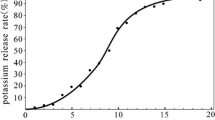Abstract
The selectivity of K over Ca of Amelia biotite increased sharply upon oxidation by H2O2 at pH 6·0. This increase in K selectivity was only partially reversible upon reduction by Na2S2O4. Oxidation by H2O2 of the Ca-form of this biotite resulted in a loss of no more than 2·8 and 0·4 per cent of the total Fe and Al, respectively, and caused a small and perhaps insignificant decrease in layer charge. Although 95 per cent of the structural Fe2+ of the Ca-form of this biotite was ozidized by H2O2, only 17 per cent was reduced again by four treatments with Na2S2O4.
The evidence indicates that under the conditions of this experiment the loss of protons from structural hydroxyls was the dominant mechanism by which electroneutrality in the biotite was maintained during oxidation of structural Fe2+. Because this mechanism increases the bond strength of interlayer K, it explains the increased K selectivity of biotite upon H2O2 oxidation. The relatively small reduction by Na2S2O4 of structural Fe3+ to Fe2+, which implies an equally small reprotonation of structural hydroxyls, explains the incomplete reversibility of K selectivity by Na2S2O4 treatment.
Résumé
La sélectivité de la biotite d’Amélia pour K vis à vis de Ca, augmente brutalement lors de l’oxydation à pH 6,0 par H2O2. Cette augmentation de sélectivité pour K est seulement partiellement réversible lors de la réduction par Na2S2O4. L’oxydation par H2O2 de la forme Ca de cette biotite entraîne une perte de Fe et Al qui ne dépasse pas 2,8 pour cent de Fe total et 0,4 pour cent de Al total, et une petite diminution, peut être non significative, de la charge du feuillet. Bien que 95 pour cent de Fe2 + de constitution de la forme Ca de cette biotite soient oxydés par H2O2, seuls 17 pour cent en sont réduits après quatre traitements par Na2S2O4.
Il est donc évident que dans les conditions de cette expérience, la perte de protons venant des hydroxyles de constitution est le mécanisme principal qui maintient l’électroneutralité de la biotite pendant l’oxydation de Fe2+ du réseau. Comme ce mécanisme augmente la force de rétention de K interfeuillet, il explique l’augmentation de sélectivité de la biotite pour K lors de l’oxydation par H2O2. La diminution relativement faible de Fe3+ qui se transforme en Fe2+ par traitement Na2S2O4, implique une reprotonation également petite des hydroxyles de constitution et explique la réversibilité incomplète de la variation de la sélectivité pour K lors des traitements Na2S2O4.
Kurzreferat
Die Selektivität von Amelia Biotit für K gegenüber Ca stieg nach Oxidation mit H2O2 bei pH 6,0 scharf an. Dieser Anstieg der K-Selektivität war nach Reduktion mit Na2S2O4 nur teilweise reversibel. Die Oxidation durch H2O2 hatte bei der Ca-Form dieses Biotits einen Verlust von nicht mehr als 2,8 prozent Gesamt-Fe und 0,4 prozent Gesamt-Al zur Folge und rief eine geringe und vielleicht nicht signifikante Abnahme der Schichtladung hervor. Obwohl 95 prozent des Gitter-Fe2+ der Ca-Form dieses Biotits durch H2O2 oxidiert wurde, wurden nur 17 prozent durch vier Behandlungen mit Na2S2O4 wieder reduziert.
Dieser Nachweis zeigt, daß unter diesen Bedingungen dieses Versuches der Verlust von Protonen aus Gitterhydroxylionen der vorherrschende Mechanismus ist, mit dem die Elektroneutralität in Biotit während der Oxidation von Gitter-Fe2+ aufrecht erhalten wird. Da dieser Mechanismus die Bindungsstärke des Zwischenschicht-K erhöht, erklärt er die Zunahme der K-Selektivität von Biotit als Folge der H2O2-Oxidation. Die verhältnismäßig geringe Reduktion des Gitter-Fe3+ zu Fe2+ durch Na2S2O4, die eine gleich geringe Reprotonierung der Gitterhydroxylionen beinhaltet, erklärt die unvollständige Reversibilität der K-Selektivität durch Na2S2O4-Behandlung.
Резюме
Избирательность биотита Амелия по К над Са резко повышается при окислении посредством Н2O2 при pH 6,0. При восстановлении Na2S2O4 это повышение избирательности по К только частично обратимо. Окисление Н2O2 формы Са этого биотита повело к потере не менее, чем 2,8 и 0,4 процента общего содержания Fe и А1, соответственно, и причинило малое, а может быть незначительное, понижение заряда слоев. Хотя, 95 процентов структурного Fe2 + формы Са этого биотита подвергалось окислению посредством Н2O2, только 17 процентов было восстановлено четырьмя переработками Na2S2O4.
Полученные данные указывают, что при этом эксперименте потеря протонов из структурных гидроксилов является преобладающим механизмом удержания электронейтральности биотита во время окисления структурного Fe2+. Так как, этот механизм усиляет связь межслойного К, это объясняет увеличение избирательности биотита по К при окислении Н2O2. Сравнительно малое восстановление Fe3+ в Fe2+ посредством Na2S2O4, означает также малую репротонацию структурных гидроксилов, и объясняет неполную обратимость избирательности по К при переработке Na2S2O4.
Similar content being viewed by others
References
Barshad, I. and Kishk, F. M. (1968) Oxidation of ferrous iron in vermiculite and biotite alters fixation and replaceability of potassium: Science 162, 1401–1402.
Barshad, I. and Kishk, F. M. (1970) Factors affecting potassium fixation and cation exchange capacities of soil vermiculite clays: Clays and Clay Minerais 18, 127–137.
Farmer, V. C., Russell, J. D., McHardy, W. J., Newman, A. C. D., Ahlrichs, J. L. and Rimsaite, J. Y. H. (1971) Evidence for loss of protons and octahedral iron from oxidized biotites and vermiculites: Miner. Mag. 38, 121–237.
Farmer, V. C. and Wilson, M. J. (1970) Experimental conversion of biotite to hydrobiotite: Nature 226, 841–842.
Gilkes, R. J., Young, R. C. and Quirk, J. P. (1972) Oxidation of octahedral iron in biotite: Clays and Clay Minerais 20, 303–315.
Jackson, M. L. (1962) Soil Chemical Analysis, pp. 272–285. Prentice Hall, New Jersey.
Juo, A. S. R. and White, J. L. (1969) Orientation of the dipole moments of hydroxyl groups in oxidized and unoxidized biotite: Science 165, 804–805.
Leonard, R. A. and Weed, S. B. (1970) Effects of potassium removal on the ft-dimension of phlogopite: Clays and Clay Minerais 18, 197–202.
LeRoux, J., Rich, C. I. and Ribbe, P. H. (1970) Ion selectivity by weathered micas as determined by électron microprobe analysis: Clays and Clay Minerais 18, 333–338.
Mehra, O. P. and Jackson, M. L. (1960) Iron oxide removal from soils and clays by a dithionite-citrate System buffered with sodium bicarbonate: Clays and Clay Minerais 7, 317–327.
Newman, A. C. D. and Brown, G. (1966) Chemical changes during the alteration of micas: Clays and Clay Minerais 6, 297–310.
Raman, K. V. and Jackson, M. L. (1966) Layer charge relations in clay minerais of micaceous soils and sediments: Clays and Clay Minerais 14, 53–68.
Reichen, L. E. and Fahey, J. J. (1962) An improved method for the détermination of FeO in rocks and minerais including garnet: Geol. Survey Bull. 1144-B, 1–5.
Robert, M. and Pedro, G. (1969) Etude des relations entre les phénomènes d’oxydation et l’aptitude à l’ouverture dans les micas trioctaédriques: Proc. Int. Clay Conf. Japan 1, 455–473.
Rosenqvist, J. Th. (1963) Studies in position and mobility of the H atoms in hydrous micas: Clays and Clay Minerais 11, 117–135.
Ross, G. J. and Rich, C. I. (1973) Effect of particle thickness on potassium exchange for phlogopite: Clays and Clay Minerais 21, 77–81.
Author information
Authors and Affiliations
Additional information
Soil Research Institute Contribution No. 478.
Rights and permissions
About this article
Cite this article
Ross, G.J., Rich, C.I. Effect of Oxidation and Reduction on Potassium Exchange of Biotite. Clays Clay Miner. 22, 355–360 (1974). https://doi.org/10.1346/CCMN.1974.0220406
Received:
Published:
Issue Date:
DOI: https://doi.org/10.1346/CCMN.1974.0220406




